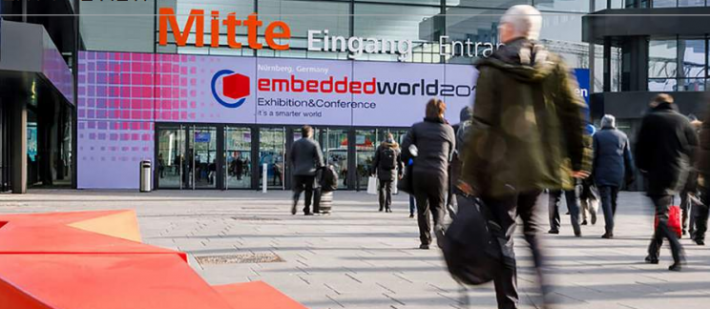From 21-23 June 2022, the 20th edition of the embedded world Conference in Nuremberg, Germany will bring together experts from all areas of research and applications of embedded systems. Antony Savvas speaks to movers and shakers in the field and asks what they expect from the show.
The conference will take place in parallel with the embeddedworld Exhibition, with the two offering more than 200 product presentations, and expert panels providing an opportunity to interact and share knowledge during the three-day event. “The range of themes covered by the embedded world Conference is constantly growing, just like the challenges that developers are facing,” says embedded world Conference chairman professor Axel Sikora of Offenburg University of Applied Sciences, and of the Hahn-Schickard Institute. “We can look forward to knowledge input on key themes such as the Internet of Things, wired and wireless data transmission hardware, operating systems, software and system engineering, autonomous systems, safety and security, system-on-chip design, embedded vision and human-machine interaction.”
“It’s nice to see experienced developers gathering in Nuremberg every year to share their knowledge and help others turn their ideas and innovations into actual products,” he adds. “Previously, embedded intelligence was essentially a vision of the future, but now it’s increasingly becoming a reality nthat impacts more and more systems, from autonomous vehicles to image recognition, and preventive and needs-based maintenance in Industry 4.0 systems, covering everything from small computers to high-powered cloud servers.”
Event delegates can look forward to six discussion rounds on various days, including Embedded Security – The Reality Check/How Much Security Do We Need?; Integration of Embedded Vision: Plug and Play or Plug and Pray?; and How Companies Can Drive Innovation. There is also Embedded AI: Why the Big Future of Machine Learning is Embedded; Chip Shortage; and AI Ethics: From Principles to Engineering.
Martin Garner, COO at research and consulting firm CCS Insight, says of the growing need for Internet of Things (IoT): “The pandemic shone a very bright light on the need for IoT across a range of sectors as companies realised they had to keep things running, without having to have people present. This has driven investment in IoT systems strongly, and many IoT players are experiencing good growth rates as a result.”
“As demand builds, there is a lot of innovation going into the architecture of IoT systems, driven by the strong growth of edge computing in various forms, and by the use of cloud-native technologies within the IoT system,” he explains. “This will make IoT systems more scalable, and able to take on a broad variety of use cases, rather than be installed only as specialist systems.”
Of the show, he adds: “As one of the world’s larger, and most complete industrial trade shows, we expect to see major product updates at embedded world helping IoT across the full spectrum, from sensors to data centres, from ethernet to 5G, and from real-time operating systems to AI frameworks.”
Artificial Intelligence
Vijai Shankar, the vice president of product and growth marketing at Uniphore, says of AI developments: “In the AI sector, and in particular how it is being deployed within customer services, we are at a watershed moment. Even before Covid, the writing was on the wall: customers were expecting companies to be more accessible, available and adept at handling their questions and concerns. In fact, a report from analyst Forrester found that customers were 2.4 times more likely to stay with a company that could solve their issues quickly.”
“Then came 2020. Inbound calls spiked. Complex and difficult calls doubled and depleted customer service teams soon found themselves overwhelmed,” he adds. “Companies responded by accelerating their digital imperatives, using the power of AI and automation to fast-track digital self-service and live chat initiatives.”
Shankar says interaction analytics have reached a “never-before-seen level of maturity”, delivering highly accurate, real-time feedback on customer emotion and intent. At the same time, advances in natural language processing (NLP) have made non-human conversations as seamless as their live counterparts,” he maintains.
CCS Insight’s Garner says: “At the same time as IoT systems are becoming more general-purpose and scalable, there is also a strong shift to focus on how to use the data they generate more effectively. Integration with other corporate systems, as well as workflows, advanced analytics and AI, are quickly becoming the key tools for extracting value and powering digital transformation.”
“The growing scope of IoT systems, and the layers of analytics and AI are bringing a huge expansion in the attack surfaces for hackers,” Garner explains. “So, suppliers are also investing heavily in IoT system security in tandem with their product innovation. IoT has a reputation for lax security, but the picture is improving quickly. And it needs to because most of the systems installed from now, will still be operating as we move into the era of quantum computing, in which much stronger encryption algorithms will be needed.”
Security
David Maidment, the senior director for the secure device ecosystem at Arm, says there has been progress in embedded security since the last show took place before the pandemic.
He says: “The pace at which the pandemic connected our digital and physical worlds through data has underlined the huge potential for the Internet of Things to be an agent for positive change. But it has also exposed and exacerbated the severity of digital risks within our more connected world.”
“Encouragingly, during this time, IoT security has also moved well beyond the stage of early adopters, and the direction of travel in the industry is clear: security is foundational, not optional,” he adds. “We’ve seen first-hand that security must be integrated into every device, process, company and culture if we are to take advantage of its potential as an enabler of digital transformation. Continued industry collaboration around security best practice is critical to driving this forward.”
Progress on security is borne out by recent research from the Wi-SUN Alliance, a global member-based association made up of companies driving the adoption of interoperable wireless solutions for use in smart cities, smart utilities and other IoT and industrial IoT applications. The report questioned 300 IoT decision-makers at UK and US companies, and found that a quarter (24%) of all respondents still believed security is one of the top three barriers to IoT adoption. But this is down from 58% five years ago in similar research. However, security and safety remains the most common technical challenge among respondents (42%).
Maidment added: “We look forward to meeting with our industry peers and partners at embedded world to reinforce best practice guidelines, a common language around security, and the use of trusted components to help streamline costs and further level the security playing field in 2022 and beyond.”
Standards
Marc Canel, the vice president of strategic business development at Imagination, says standards are continuing to drive forward the IoT industry. “Many industries have adopted IoT as it enables so many different new use cases such as early maintenance, security, manufacturing process optimisation, automated driving and smart homes,” he explains.
“Connectivity technologies played a key role in the growth of IoT, and the development of standardised security models, such as the Security Evaluation Standard for IoT Platforms (SESIP) allowed companies to harmonise solutions for specific use cases,” says Canel. “All these innovations in IoT have brought forward the effectiveness of integrating IoT solutions from the device to the edge of the network and to the cloud.”
According to the Wi-SUN Alliance research, the biggest change for IoT adopters when considering a smart cities solution has been the importance of industry-wide open standards for IoT deployments. In its report, 86% of respondents feel that this is either ‘very important’ or ‘absolutely crucial’, up from 78% five years ago. While 84%, up from 79% in 2017, believe the same when considering a smart utilities solution.
Also, more respondents are demanding no vendor lock-ins as a specific feature in 2022 (78%, up from 66% in 2017), reinforcing the need for open standards, which make it easier to integrate new IoT solutions, devices and software with existing infrastructure.
Canel says of the show: “embedded world is a great platform for industry leaders to highlight the benefits of IoT across applications – be it accelerating manufacturing SME growth, advancing the connected car data architecture or driving digital transformation in digital twin use cases.”
Whatever the embedded debate, you can certainly find them all at embedded world.
Comment on this article below or via Twitter: @IoTNow_










